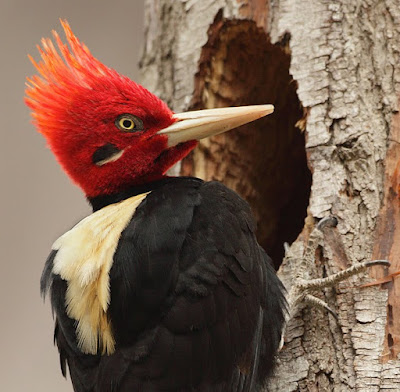Originally posted 3/20/2010 - backdated to organize posts by topic.
Some of the best woodpecker photos (
Campephilus and others) that you will ever find are at a site called
PicidPics, like this fantastic photo of a male
Cream-backed Woodpecker.
PicidPics features photos of picids, including woodpeckers, piculets and wrynecks by
Martjan Lammertink and
Julio Pérez Cañestro. The site also features photos of woodpecker researchers in the field and photos of secondary cavity users.
Photo © Martjan Lammertink, posted here with permission.
This photo shows the bird's pale creamy mantle in excellent detail. The male has a bright red head with black and white marks at the lower rear edge of its ear coverts. Like some
Campephilus relatives, the Cream-backed Woodpecker has a striking chisel-shaped, ivory-colored bill.
You can also see here the long toe that the large
Campephilus woodpeckers extend to their side to secure their stance against a tree. It's a good brace against gravity! You'd probably extend your arms out to either side like this if you found yourself braced against a cliff on a narrow ledge.
The Cream-backed Woodpecker inhabits subtropical and dry tropical forests in south central South America in Argentina, Brazil, Paraguay and Uruguay. Unlike several of its close relatives, this species occurs in savannas, and it can be observed visiting isolated trees in open areas.




















































